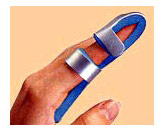 If you are a catcher, and have been catching for any significant length of time, then you know all about jammed fingers. A jammed, or sprained, finger is often the result of your bare hand being in the wrong place at the wrong time. Similarly, if you are a baseball player that plays “hard”, you’ve likely sprained a finger while sliding headfirst into a base or diving for a fly ball.
If you are a catcher, and have been catching for any significant length of time, then you know all about jammed fingers. A jammed, or sprained, finger is often the result of your bare hand being in the wrong place at the wrong time. Similarly, if you are a baseball player that plays “hard”, you’ve likely sprained a finger while sliding headfirst into a base or diving for a fly ball.
When one of your fingers gets bent backward or sideways much further than God intended, the result is what’s technically known as a sprain. It’s probably the most common of all sports injuries, and in most cases, not much to be concerned with. Assuming all you have is a minor sprain, you can usually play through it, albeit with pain.
Before you decide to play through a jammed finger, however, you need to make sure it is indeed a sprain and not a dislocation or fracture. The symptoms of a simple sprain is pain, redness, and swelling around the joint/knuckle, and limited range of motion. If the pain is in the middle of your finger bone, you may have a fracture and should get X-rays immediately. Similarly, if the pain is acute, and/or you can’t move the finger at all, and/or the finger looks abnormally twisted or disfigured, get out of the game and seek medical attention. Also, if the injury was the result of a direct blow to the tip of one of your fingers — such as from a foul tip — you will want to seek medical attention in case it is “mallet finger“, which if left untreated could cause permanent deformity.
Let’s get back to the sprain. If you’ve jammed or hyperextended one of your fingers, there is going to be some pain, and a lot of swelling. You can grit your teeth and get through the game, but immediately afterward you should ice it several times that day and during the next 3-5 days — 15 minutes on ice, at least 25 minutes off. This will reduce the swelling, as will taking some aspirin, ibuprofen, or similar anti-inflammatory.
Should the sprain be in one of your knuckle joints, and you don’t have a game the next day, you may want to splint it. It can be as simple as taping a popsicle stick to your finger to keep it straight, though it’s better to see a trainer, school nurse, or doctor and have a professional splint it for you.
If you’re a dumb, bullheaded lug like me and too tough to see professionals — and insist on playing the next day — you can “buddy tape” the injured finger to the one next to it and continue to play. Regardless of whether you’re smart and seek some medical attention or a mule such as me, try to avoid using the jammed finger as much as possible, and continue ice treatment, for several days. Once the swelling starts to go down, you should start doing easy motion exercises — such as simply turning the finger around in circles or gently bending it back and forth. As the swelling and pain continues to diminish, do the same exercises with some resistance — a few rubber bands work well and allow you to gradually build up strength. You can also squeeze a pink rubber ball or anti-stress device. Once the swelling goes down, you’ll want to get that digit moving and working sooner rather than later.
Treated properly, your jammed finger should be back to normal within a few weeks — often sooner. Remember the two key phrases when dealing with sprains: “Ice is nice, and, motion is lotion.” Ice for immediate treatment of swelling and pain, motion after the swelling and pain subsides.
Leave a Reply